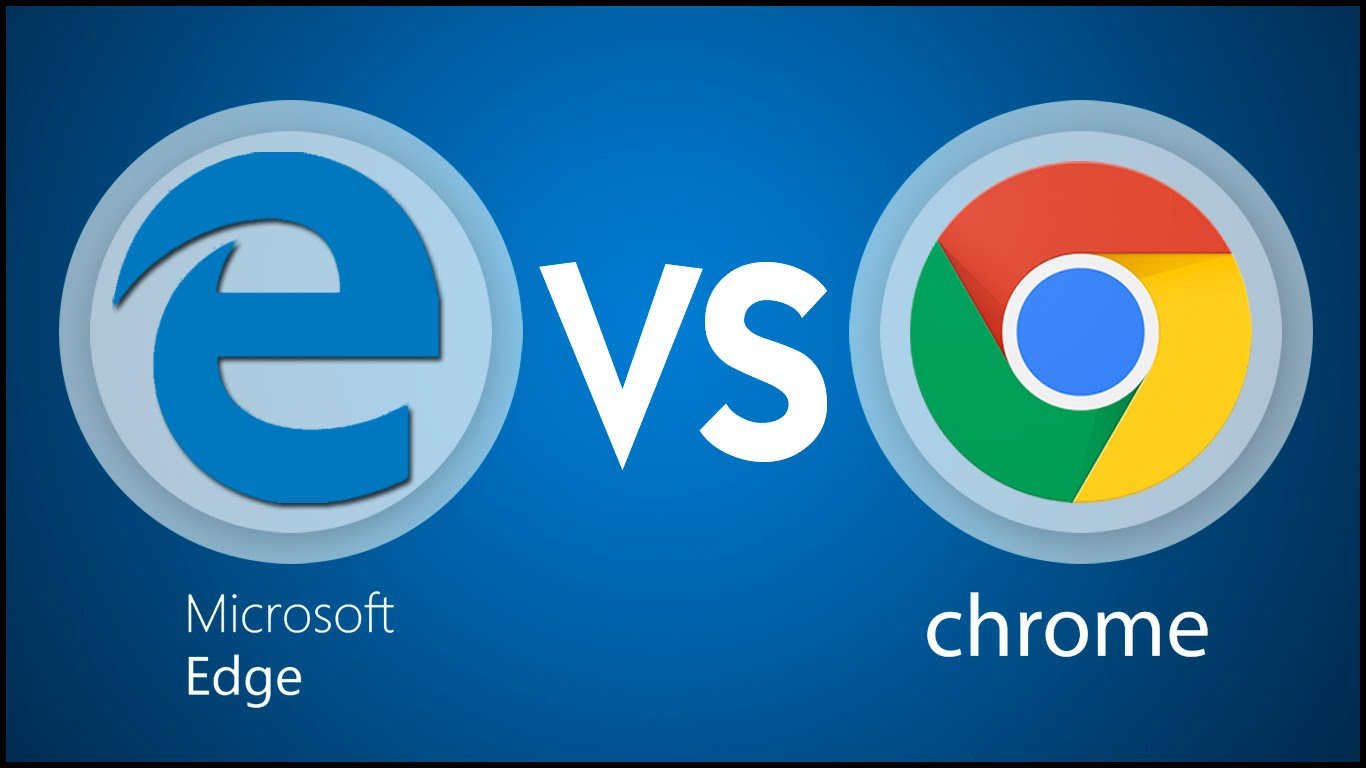Google’s Chrome browser is the king of browsers for the past few years but the competitions never giving up. Especially Microsoft. The software monster tried really hard to get Internet Explorer back in the game but that gets some negatives. So Microsoft return back to battle again with their new Microsoft Edge browser for Windows 10.
Microsoft provides a wonderful experience with Microsoft Edge and you know that’s pretty true if you are an edge user. It’s quite clear if you are skeptical of using Edge due to your bad experiences with Internet Explorer but you should absolutely give Microsoft’s new browser a try.
[ad type=”square”]Most of the people across the globe using Google Chrome as default browser but off late people have started to face some issues, especially on PCs that feature modest hardware. There have also been privacy concerns around the browser. Thanks to these reasons, people are looking for an alternative that matches Chrome’s simplicity and speed. This is where Microsoft Edge comes into play. Edge might still be a budding new browser but let’s see if it manages to take on Google Chrome.
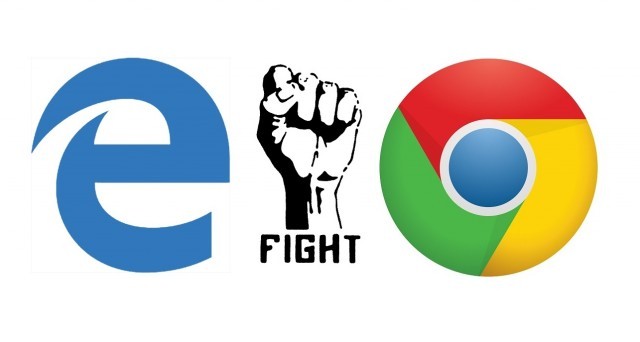
Note:
- To cater to more people across the globe, we are using a modestly powered PC featuring a Core i3 processor and 4 GB RAM for our testing. We are carrying out these tests on a fresh install of Google Chrome (v 45.0.2454.101 m) and Microsoft Edge (v 20.10240.16384) on Windows 10.
- Just so you should know, we cleared the cache after every test on both the browsers.
- We have taken an average out of 3 scores from the Benchmark tests for better accuracy.
1. Real World Usage Comparison
Start-up Time
The time browsers took to start.
- Microsoft Edge: 1.13 seconds
- Google Chrome: 1.53 seconds
Verdict: Microsoft Edge was slightly quicker to load but we are pretty sure you won’t notice the difference.
Page Rendering Time
We loaded Wikitechy on both the browsers and noted the time.
- Microsoft Edge: 2.57 seconds
- Google Chrome: 2.63 seconds
We also tested the page rendering speed by loading Techcrunch.
- Microsoft Edge: 4.21 seconds
- Google Chrome: 3.58 seconds
Then, we loaded the heavy USA Today website.
- Microsoft Edge: 5.87 seconds
- Google Chrome: 4.33 seconds
Verdict: Google Chrome wins here by a very slight margin.
Memory Usage
We opened 8 tabs (Wikitechy, Gmail, Windows Blog, Official Android Blog, MSN, YouTube, Facebook and Twitter) on both the browsers and took note of the amount of memory they consumed.
- Microsoft Edge: 1018 MB
- Google Chrome: 516 MB
Verdict: Google Chrome has always been known to be a memory hog but it surprisingly did better than Microsoft Edge, which took a lot of memory.
2. Benchmark Comparison
While real word usage and performance is what matters when it comes to browsers, we tested the browsers on a few benchmark tests to please our geeky readers.
-
Jetstream
Jetstream is a bench marking suite to test the JavaScript standard on a browser and to see how well the web apps would perform.

HTML5 Test
HTML5 Test is a browser benchmark tool to see how well your browser supports HTML5.
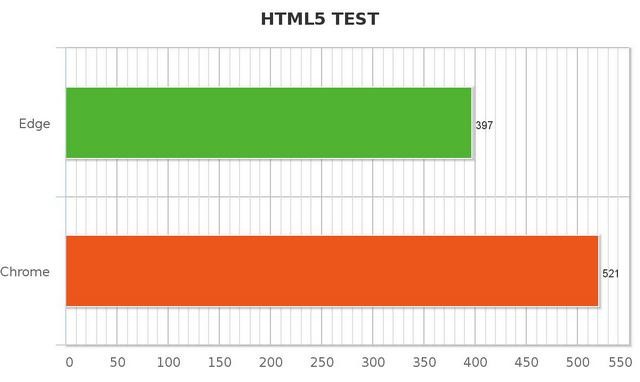
-
Peacekeeper
Peacekeeper is a universal browser speed test, which works with mostly all platforms.
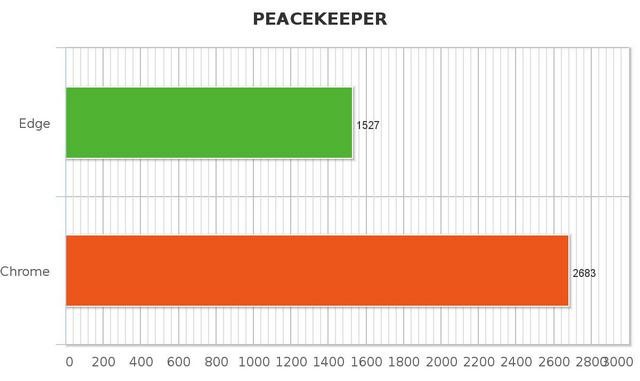
-
Octane
Octane is another Javascript performance benchmark tool, which tests various JavaScript standards to let you know your browser’s performance.
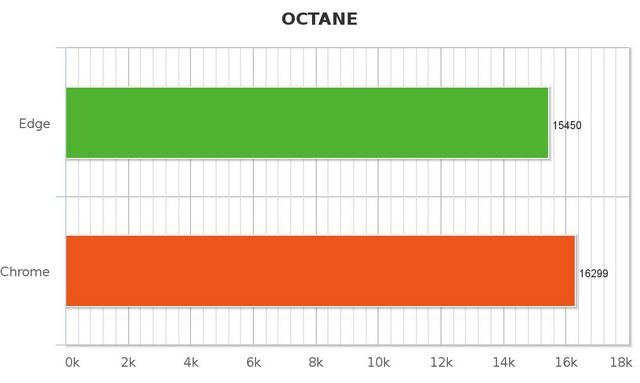
Verdict
Google Chrome is the clear winner here. While Microsoft Edge does manage to beat Google’s browser in the Jetstream Javascript benchmark, it gets beaten in all other tests.
3. Compatibility
Platforms
-
Google Chrome
Android, Windows, OS X, iOS, Chrome OS.
-
Microsoft Edge
Windows 10 and Windows 10 Mobile
-
Verdict
Google Chrome is the clear winner here, as it supports almost all major platforms we know of. The vast platform support means your data can be synced on multiple devices.
[ad type=”banner”]Web Standards
-
Google Chrome
The latest Google Chrome version comes with support for new web standards like WebP (new web image format). Chrome was also one of the first web browsers to support HTML5 and Google is still a key contributor to the web standard. Google is also a founding member of W3C Web Performance Working group, so Chrome will always be up to date with the latest web standards.
-
Microsoft Edge
Microsoft has apparently worked really hard to meet modern web standards with Edge, even though the browser features a forked version of “Trident”(IE’s rendering engine) called Microsoft EdgeHTML. Edge’s layout engine has been build to support modern web standards like Shell Helper API, custom download managers and more. That also means no more support for legacy web standards like Active X, DirectX Filters, Silverlight etc. While Edge does come with support for all major web standards, they still need improvements as benchmark scores suggest.
-
Verdict
Google Chrome wins here and it’s no surprise, considering Edge is new and it should take some time before it can compete with Google Chrome on the web standards front.
4. Privacy and Security
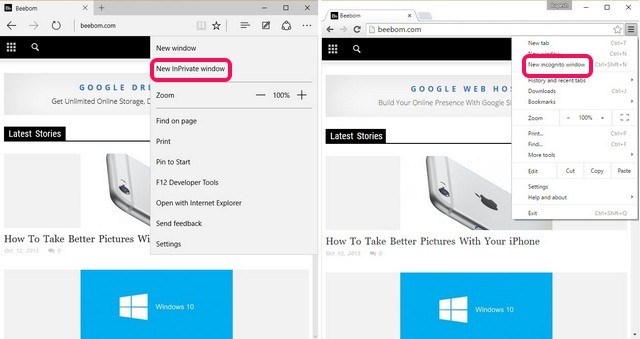
-
Google Chrome
There have been concerns regarding Google’s data hogging with Chrome but if you are okay with that, Chrome is a pretty secure browser. There are security features like Sandboxing, which prevents malicious code from a website along with securing plugins. Chrome also comes with a “Safe Browsing” technology, which shows you a warning if it thinks the website may contain malware or phishing.
When it comes to privacy, Google Chrome gives you various features like Do not track and Incognito mode, which lets you browse websites without it appearing in Chrome’s history or record. Chrome also lets you customise your privacy features in the Settings for various websites. You can change your privacy preferences for suggestions in Omnibox, cookies, images and more.
-
Microsoft Edge
Internet Explorer was panned over the years for being not-so-secure and Microsoft has apparently learned its lesson. Microsoft Edge features a host of modern technologies, which makes it one of the most secure browsers. There’s support for SmartScreen, which Microsoft introduced a few years back. SmartScreen performs a check on questionable websites to prevent them from downloading malicious content to your device. Microsoft’s “Certificate Reputation” is also part of Edge and it detects fake websites. The browser also comes with sandboxing or as Microsoft likes to call it “Protected Mode“. Along with that, Edge also brings security against memory corruption and other security vulnerabilities.
On the privacy front, Microsoft Edge comes with support for InPrivate tabs, which is the same as Incognito mode. There’s also support for Do not Track option along with options for saving passwords, filling up web forms, pop-ups, media licenses and more.
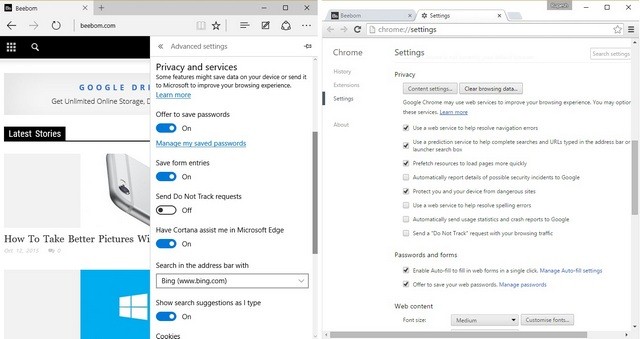
Verdict
Microsoft Edge is the winner here, as it brings a host of new security features. The browser also supports all the privacy options we know of.
5. User Experience

-
Google Chrome
Google Chrome is a fan favourite browser, thanks to its speedy experience and simplistic user interface. The interface is clean with the top region only featuring the address/search bar along with back, forward and refresh options. You can have a bookmarks bar below or you can choose to hide it. Chrome also packs in several options in the right click menu which Edge lacks.
We surely love the Chrome’s ease of use, as it lets you concentrate on your web experience rather than shoving features to your face. The user experience is great, thanks to the minimalist design and smooth operation.
-
Microsoft Edge
Internet Explorer was an outdated browser with a cluttered user experience but Microsoft Edge is nothing like it. Microsoft Edge brings a modern looking, fast web experience that makes IE look like a fossil. Edge does resemble a bit to Chrome, with streamlined address/search bar. The address/search bar pack a few edgy features like Reading view, Bookmark star button, Hub, Web note, Share and a button for more actions, settings.
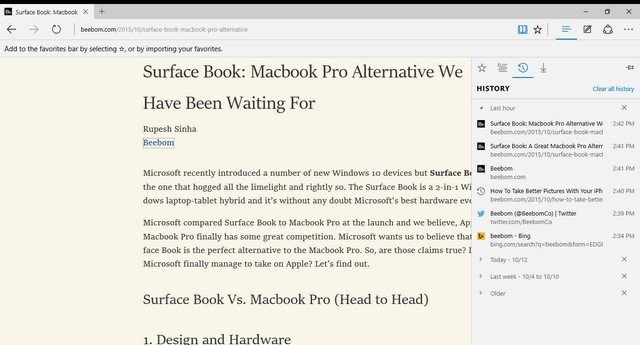
We quite like the user experience on Microsoft Edge, it is fast, fluid and smooth. The buttons on the right of the address/search bar are also quite useful in day to day usage. The integration with Windows’ digital assistant Cortana also greatly enhances the experience.
-
Verdict
It’s a tough one but Microsoft Edge takes the honours here, thanks to its fresh design and fast user experience. The features like Reading View, Hub and Cortana integration make the browser interesting.
6. Features
-
Google Chrome

Google Chrome has been in the industry for a long time and thanks to its rich and constantly updated feature list, it has always remained relevant. Chrome has a number of options, which make it a fan favourite. There are various web apps, plugins and extensions that increase the browser’s functionality several folds. The browser comes with great tab management, built-in PDF viewer and more. It also lets you sync all your data like passwords, web forms, bookmarks from one device to another by simply logging in. There are a plethora of other Chrome features that make the experience much better.
-
Microsoft Edge
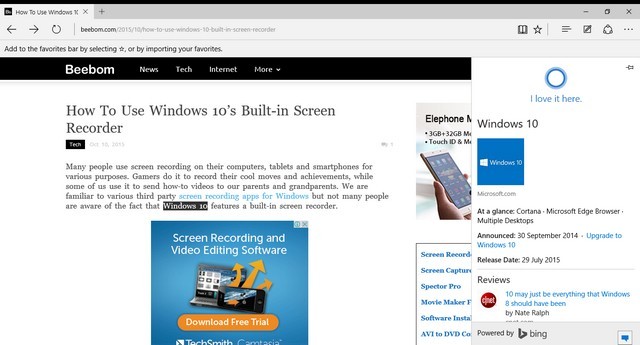
Microsoft knew that it had to bring something unique to the table to make people use Edge and that’s what exactly it has done. Microsoft Edge comes with some really cool features like integration with Cortana that works really well. Then there’s a new Reading mode, Reading list, ability to doodle directly on the web page and more. There’s also a cool new Hub, which features your downloads, history and reading list. Along with that, Edge features a cool sharing panel for quick sharing of links. There are some Windows 10-centric features like the ability to pin web pages to the Start menu. The feature list on Edge is already pretty good but it should get better with next update. Microsoft has promised extensions support in the future updates, so we are looking forward to it.
-
Verdict
Google Chrome wins here just by a slight margin. Chrome is a mature and feature rich browser and even though Microsoft Edge has some great unique features, it still lacks some of them.
7. Chrome vs Edge (Table)
| Microsoft Edge | Google Chrome | |
| Flash Support | Yes | Yes |
| Extensions | No | Yes |
| Reading Mode | Yes | No |
| Plug-in Security | Yes | Yes |
| Sandboxing | Yes | Yes |
| Private Browsing | Yes | Yes |
| WebM support | No | Yes |
| Audio & Video Track Selection | Yes | No |
| JPED-XR support | No | Yes |
| Web Notifications | No | Yes |
Conclusion
Google Chrome is the most used browser across the globe, as the data suggests but we are glad Microsoft is finally rising up to the occasion. Microsoft Edge won’t be unseating Chrome from the top spot anytime soon but the new unique features do make us think that the Redmond giant is headed in the right direction.
Chrome is indeed a better choice among the two but the difference should lessen for sure in the coming future. For what’s its worth, you should definitely give Microsoft Edge a try.
